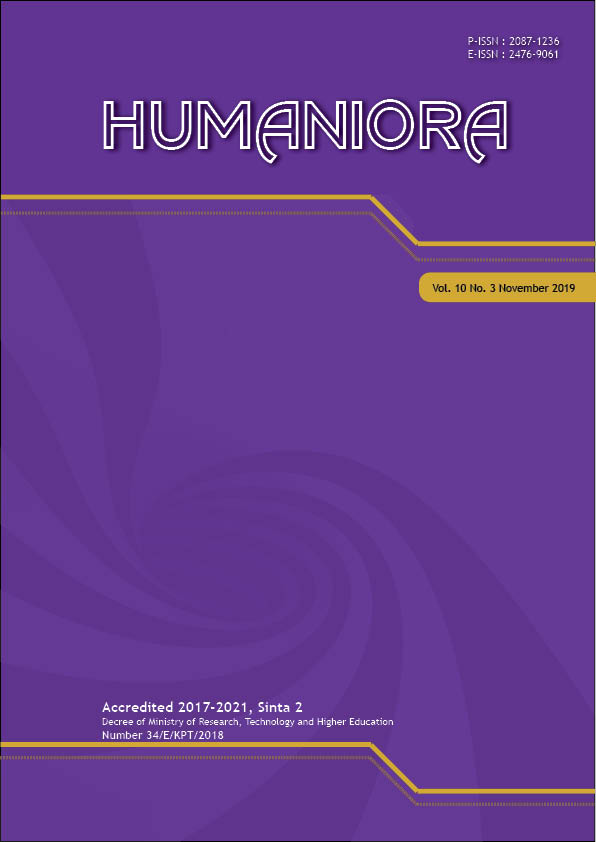Developing Ways of Thinking in Society Using Online Video: A Case of Sexy Killers Video
DOI:
https://doi.org/10.21512/humaniora.v10i3.5750Keywords:
online video, ways of thinking, society thinkingAbstract
This research aimed to explain the online video, ‘Sexy Killers’, to build a way of thinking in society. The problem of this research limited to the role of online video in conveying messages that could build positivity in the community. It had a focus on how much the impact of online video could affect the way of thinking in society by using online video ‘Sexy Killers’ and looked at the responses of the audience’s comments after receiving the message contained in this video. The method used in the research was a qualitative method documentation that the researcher would document any opinion in column comments by giving the right impression that had obtained positive (build) and negative. The results of this research are the video “Sexy Killers†has succeeded in design online video recommendations that can build a way of thinking in a society that has a positive impact.
Â
References
Akram, W., & Kumar, R. (2018). A study on positive and negative effects of social media on society. International Journal of Computer Sciences and Engineering, 5(10), 351–354. https://doi.org/10.26438/ijcse/v5i10.351354.
Atrees, F. F. (2013). The concept of subliminal messages in brand design. The International Design Journal, 3(1), 23–28. Retrieved from http://www.journal.faadesign.com/pdf/5-1-faten.pdf.
Baruah, T. D. (2012). Effectiveness of social media as a tool of communication and its potential for technology enabled connections: A micro-level study. International Journal of Scientific and Research Publications, 2(5), 1–10. Retrieved from http://www.ijsrp.org/.
Berger, J., & Milkman, K. L. (2012). What makes online content viral? Journal of Marketing Research, 49(2), 1–13. https://doi.org/https://doi.org/10.1509/jmr.10.0353.
Drago, E. (2015). The effect of technology on face-to-face communication. The Elon Journal of Undergraduate Research in Communications, 6(1), 13–19.
Durkheim, E. (2014). Primitive classification (Routledge revivals). London: Routledge. https://doi.org/10.4324/9780203092828
Fahrurozi, S. K., Maryono, D., & Budiyanto, C. W. (2017). The development of video learning to deliver a basic algorithm learning. Indonesian Journal Informatis Education, 1(2), 49-56. https://doi.org/10.20961/ijie.v1i2.12446.
Ganda, M. (2014). Social media and self: Influences on the formation of identity and understanding of self through social networking sites. Unpublished Thesis. Portland: Portland State University. https://doi.org/10.15760/honors.64.
Gisbert, P. (1959). Social facts in Durkheim’s system. Anthrophos, 53(3/4), 359-369.
Harriman, P. L. (1977). Handbook of psychological terms. Litlefield: Adams & Company.
Holland, M. (2017). How YouTube developed into a successful platform for user-generated content. Young & Creative - Digital Technologies Empowering Children in Everyday Life, 7(1), 52–69. https://doi.org/10.1016/j.virusres.2006.01.022.
Internet Society. (2015). Global internet report. Retrieved from http://www.internetsociety.org/doc/global-internet-report.
Kettler, T. (2017). What constitutes good thinking? Texas: University of North Texas. https://doi.org/doi:10.13140/RG.2.2.11673.31842.
Khan, M. L. (2017). Social media engagement: What motivates user participation and consumption on YouTube? Computers in Human Behavior, 66, 236–247. https://doi.org/10.1016/j.chb.2016.09.024.
Levchenko, V. F., Kazansky, A. B., Sabirov, M. A., Semenova, E. M. (2012). Early biosphere: Origin and evolution. The Biosphere, 1–32.
Mehraj, H. K., Bhat, A. N., & Mehraj, H. R. (2014). Impact of media on society: A sociological perspective. International Journal of Humanities and Social Science Invention, 3(6), 56–64.
Nikopoulou-Smyrni, P., & Nikopoulos, C. (2010). Evaluating the impact of video-based versus traditional lectures on student learning. Educational Research, 1(8), 2141–5161. Retrieved from http://www.interesjournals.org/ER.
Ravi, B. K. (2012). New media, culture, and society. Academic Research International, 2(2), 479–494.
Reeves, S., Albert, M., Kuper, A., & Hodges, B. D. (2008). Qualitative research: Why use theories in qualitative research? Retrieved from https://doi.org/10.1136/bmj.a949.
Schwarzl, S., & Grabowska, M. (2015). Оnline marketing strategies: The future is here. Journal of International Studies, 8(2), 187–196. https://doi.org/10.14254/2071-8330.2015/8-2/16.
Watchdoc Image. (2019). Sexy killers. Indonesia: Youtube. Retrieved from https://www.youtube.com/watch?v=qlB7vg4I-To.
Weiyan, L. (2015). A historical overview of uses and gratifications theory. Cross-Cultural Communication, 11(9), 71–78. https://doi.org/10.3968/7415.
Downloads
Published
How to Cite
Issue
Section
License
Authors who publish with this journal agree to the following terms:
a. Authors retain copyright and grant the journal right of first publication with the work simultaneously licensed under a Creative Commons Attribution License - Share Alike that allows others to share the work with an acknowledgment of the work's authorship and initial publication in this journal.
b. Authors are able to enter into separate, additional contractual arrangements for the non-exclusive distribution of the journal's published version of the work (e.g., post it to an institutional repository or publish it in a book), with an acknowledgment of its initial publication in this journal.
c. Authors are permitted and encouraged to post their work online (e.g., in institutional repositories or on their website) prior to and during the submission process, as it can lead to productive exchanges, as well as earlier and greater citation of published work.
USER RIGHTS
All articles published Open Access will be immediately and permanently free for everyone to read and download. We are continuously working with our author communities to select the best choice of license options, currently being defined for this journal as follows: Creative Commons Attribution-Share Alike (CC BY-SA)




















